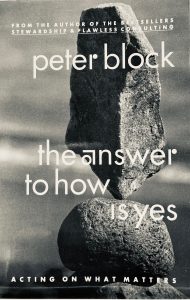Originally published in the AIA NSW Chapter Bulletin Futures Issue.
Sydney is recovering from smoke haze that was five times above the hazardous rating with 81 bush fires burning across the state – half of them still to be contained.
There is a corner of my library for desperate dystopias. Cormac McCarthy’s The Road, The Mandibles: A Family, 2029-2047 by Lionel Shriver and JG Ballard’s The Drowned World make a trio of nuclear, economic and geological catastrophe. Non-fiction reading right now is just as distressing. Bill McKibben hasn’t quite thrown in the towel; in Falter he hopes that solar power and non-violent citizen revolt might still make enough of a difference. Naomi Klein’s On Fire is amplifying Greta Thunberg’s message that we should act as if our actual house was on fire, because it is. If you ignored the multiple smoke alarms long enough to read one book right now, On Fire would be my pick. Klein bundles up her articles and speeches from the last decade and sets out the case for the Green New Deal. A compelling future does still seem possible.
I’ve spent thirty years helping organisations get the most out of a new building by using both the design process and the built environment as a lever for doing things differently – in the future. I have a low-tech toolkit with butcher’s paper and post-its that’s all about getting people in a room to talk about change.
I seed these conversations with future scenarios. If you google CRC scenarios 2040 you can see an extraordinarily vivid series of propositions for a low carbon future.1 Or head to YouTube and search for Microsoft: Productivity Future Vision.2 That’s Macquarie Bank’s Shelley Street campus in the workplace vision – a hypothetical that lets us see the future as part of a continuous present.
But in 2019, the environment is not just one uncertain element in scenarios that explore artificial intelligence, machine learning, globalisation and demographics. Bill McKibben put it best when he said, “the physical world is going from background to foreground”. The future is happening right now. And the global scientific community says we must move further and faster if we’re going to avoid “untold suffering“.3 Business as usual for our planet is suicide.
We’ve signed up to declare the climate emergency. Do we still have time to bring people together to talk about what we do next? For once the scope of work calls for transformation at all levels of society, not change management. The challenge has sent me back to revisit another book: The Answer to How is Yes: Acting on What Matters (Berret-Koehler 2002) by Peter Block, an American author and consultant in organisation development and community engagement.4 Beautifully illustrated by photographs of impossible rock balancing sculptures by Bill Dan, this has never been an easy read for me. Block picks up the challenge of hastening slowly – an idea as unlikely as the rock sculpture. The paradox at the heart of the book is that letting go of the practical imperative is the best way to find a larger sense of where we want to go and what values we want to embody in getting there.

Block’s thesis is that transformation comes more from pursuing profound questions than seeking practical answers. Asking how to do something is a defense against action. We yield too easily to what is “doable and practical and popular” instead of “pursuing what most matters to us and living with the adventure and anxiety that this requires.” The risk manager focuses on practical questions like these:
Question 1: How do you do it?
Question 2: How long will it take?
Question 3: How much does it cost?
Question 4: How do you get those people to change?
Question 5: How do we measure it?
Question 6: How have other people done it successfully?
Taken in isolation, and asked in the right context, all the “How” questions are valid. But when they become the primary questions, they keep us operating inside boundaries that don’t serve as well. “How?” is the wrong question to start with, “when asked too soon and taken too literally it may actually postpone the future and keep us encased in our present way of thinking.” Block suggests six alternative questions – “Yes” questions – that draw us into what matters:
Question 1: What refusal have I been postponing? What have I said yes to that I didn’t really mean?
Question 2: What commitment am I willing to make? Because authentic transformation needs more time than we ever imagined.
Question 3: What is the price I am willing to pay? Because money is the most common rationalisation for inaction.
Question 4: What is my contribution to the problem I am concerned with? This question gets us out of the audience and onto the stage.
Question 5: What is the crossroad at which I find myself at this point in my life/work? Does this change have value and meaning for me?
Question 6: What do we want to create together? How will the world be different tomorrow as a result of what we do today?
Each “Yes” question becomes the counter to the “How” question. Block then explores aspects of the human condition that support our pursuit of what matters: idealism, relationships, intimacy and depth. And the shifts in thinking are translated into action when we embrace terms such as radical, activist or citizen.
Each time I come back to this book the “Yes” questions have always seemed to be too much for my clients – too intimate, too idealistic, too provocative. But right now, they seem perfect for a citizen facing an apocalyptic present and a shrinking window to act for the future.
2 https://www.youtube.com/watch?v=w-tFdreZB94
3 https://academic.oup.com/bioscience/advance-article/doi/10.1093/biosci/biz088/5610806
4 http://peterblock.com/
Sue Wittenoom is the founder of The Soft Build, a change strategy consultancy for the renewal and reinvention of buildings, spaces and people.
